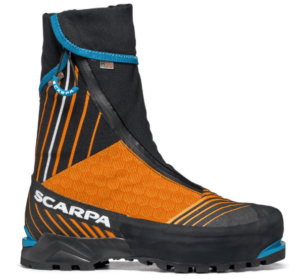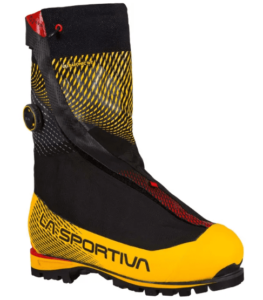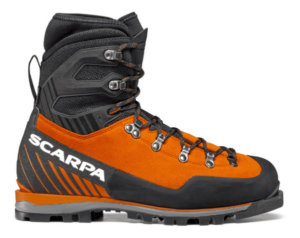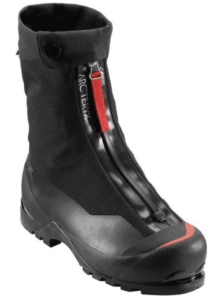“Ice Climbing Footwear Guide: How to Buy Ice Climbing Shoes for the Best Experience“
Ice climbing requires a lot of technical talent, but only to a certain extent. Also, you’re depending on your boots to keep you warm and keep you attached to the wall. Finding the ideal mountaineering boots might take some time, but with little effort, you can discover a pair you can rely on. We are quite passionate about ice; thus, we are incredibly picky about the equipment we use. To assist you choose the best footwear for your upcoming adventure, we’ve put up the following guide.
TIP: Here is how you can build a (DIY) rock climbing wall at home, happy climbing.
How To Pick The Right Mountaineering Boots
When ice climbing, you often use a technique called “front-pointing,” in which you repeatedly pound your foot into the ice to push the crampon in and give you a grip. When front-pointing in an inappropriately fitting boot, your toes will rub against it and cause pain and discomfort, making it impossible to enjoy. Choosing the proper ice climbing boot size is crucial to your comfort and effectiveness.
- Mountaineering boots should often be purchased one-half size to one full size larger than your street shoes for comfort.
- Your climbing boots should be big enough to fit warm, thick socks without being excessively roomy.
- Your new boots ought to be roomy enough for your heel to rise slightly away from the footbed without pressing abrasively against the boot’s rear. A roomier fit will also save your toes from awkwardly squeezing into the front of the boot on long descents.
- Pick the boot brand and model that fit you the best. Don’t pick a pair of boots solely on price, color, or other aesthetic factors. Make sure the boot is the proper size to accommodate your toe room and heel lift.
- Before going on your trip, make sure your footwear is broken in. Try them on nearby trails to notice how your heels and toes react to the slope.
Different Styles Of Ice Climbing Shoes
· Single Mountaineering Boots
As the name implies, single mountaineering boots only have one boot, as opposed to the replaceable liner boot that a double boot would have. Compared to other types of mountaineering boots, they frequently weigh less and have a lower profile. They are appropriate for approach walks and alpine-style climbs because of their slim shape, which frequently increases mobility, but at the expense of some insulation.
They are not recommended for multi-day treks in very wet situations when you can’t adequately dry them out at the end of the day because they are a single boot and can take longer to dry out.
· Double Mountaineering Boots
Double mountaineering boots include an insulated liner boot that may be removed in addition to a structural outer boot. They are often thicker and a little bit heavier than single boots, but they do provide a compromise because they are warmer. To keep your inner booties warm while you sleep, place them inside the body of your sleeping bag. They will be more appealing and efficient at keeping your feet warm than cold single boots, even if they are not totally dry. Double boots are excessively heavy and bulky for approaches below the snowline because they limit mobility.
· Hybrid/Integrated Gaiter Mountaineering Boots
The hybrid mountaineering boot, which sits halfway between a single boot and a double boot, is gaining popularity. With the inclusion of an integrated gaiter for additional warmth and snow protection, they may be more identical to single boots than double boots, however, this also helps to keep them drier than a single boot if they do become wet.
The 5 Best Ice Climbing Boots In 2022

1. Scarpa Phantom Tech
It’s difficult to criticize the Scarpa Phantom Tech. It excels as an all-rounder and performs admirably in the cold and on tricky ice. They are among the most preferred boots among ice climbers and mountain guides. The Phantom Tech’s structure is its primary point of distinction. It has Vibram soles, Prim aloft insulation, and a built-in gaiter, so it meets all the essential criteria for quality. It is the lightest alpine single boot on this list.

2. La Sportiva G2 Evo Mountaineering Boot
The La Sportiva G2 Evo is a great option to take into account if you want to perform your ice climbing in exceptionally chilly locations or have a few significant peaks coming up. There is no escaping the reality that this footwear is quite pricey. The biggest evidence of its greatness, though, is that it is still exceptional value for money.

3. La Sportiva Trango Tower Extreme GTX
They’re quite light for a full-shank boot, and the ankle flexibility makes them excellent for hiking, rock climbing without crampons, and mixed terrain. It has a reliable lacing design that even a little child could use. Because of the low cuff, water may slosh into the top of the boot when crossing a shallow stream. This is a wonderful boot for climbers who need a technical boot for spring, summer, and autumn routes as well as for winter climbers with warm feet on light-and-fast missions.

4. Scarpa Mont Blanc Pro GTX
You’re probably not looking for something particularly challenging if you’re new to ice climbing. It is sufficient to have thick leather boots that are automatically compatible with crampons. For new climbers taking on spring and summer ascents, the Scarpa Mont Blanc Pro GTX is a fantastic option. You receive exactly the right amount of warmth and technical performance without being too much.

5. Arc’teryx Acrux AR
The Acrux AR climbing boot is another example of how boldly Arc’teryx designs its products. The Acrux AR looks like it could kick a mountain to pieces and it may be the most durable. It is sleek and black with just a tinge of red. There aren’t many seams on the Acrux AR, which is good because seams are considered to be weak spots in mountaineering boots. The Gore-Tex-lined inner boot, which resembles a thick, stretchy sock, is protected by a completely waterproof zipper. The Acrux AR will be excellent for anything from ice climbing to alpine-style climbs in terms of ideal usage.






